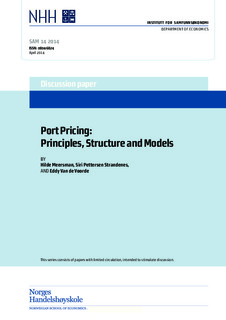| dc.contributor.author | Meersman, Hilde | |
| dc.contributor.author | Strandenes, Siri Pettersen | |
| dc.contributor.author | Van de Voorde, Eddy | |
| dc.date.accessioned | 2014-05-02T12:41:51Z | |
| dc.date.available | 2014-05-02T12:41:51Z | |
| dc.date.issued | 2014-04 | |
| dc.identifier.issn | 0804-6824 | |
| dc.identifier.uri | http://hdl.handle.net/11250/194585 | |
| dc.description.abstract | Price level and price transparency are input to shippers’ choice of supply chain and
transport mode. In this paper, we analyse current port pricing structures in the light of
the pricing literature and consider opportunities for improvement. We present a
detailed overview of pricing criteria, who sets prices and who ultimately foots the bill
for port-of-call charges, cargo-handling fees and congestion charges. Current port
pricing practice is based on a rather linear structure and fails to incorporate modern
pricing tools such as price differentiation or revenue management. Consequently,
ports apply neither profit maximising pricing nor pricing designed to exploit available
capacity more efficiently. | nb_NO |
| dc.language.iso | eng | nb_NO |
| dc.publisher | Norwegian School of Economics. Department of Economics | nb_NO |
| dc.relation.ispartofseries | Discussion paper;14/2014 | |
| dc.subject | VDP::Samfunnsvitenskap: 200::Økonomi: 210::Samfunnsøkonomi: 212 | nb_NO |
| dc.subject | infrastructure pricing | nb_NO |
| dc.subject | pricing models | nb_NO |
| dc.subject | seaports | nb_NO |
| dc.title | Port pricing : principles, structure and models | nb_NO |
| dc.type | Working paper | nb_NO |
